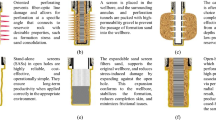Abstract
The present study examined the effect of electric fields in calcium carbonate (CaCO3) scale formation on a heat transfer surface. The effects of electric fields ranging from 0 V to 4000 V on the fouling properties of CaCO3 were investigated. Results showed that the optimal electric voltage was approximately 500 V, at which the asymptotic value of fouling resistance and the deposited weight were minimal and corresponded to 52.8 % and 61.3 % reductions, respectively, compared with the results recorded at 0 V. At higher voltages of 3000 V or 4000 V, the asymptotic value of fouling resistance and the weight of fouling deposits increased relative to those obtained at 0 V. The scanning electron microscope images of the fouling deposits obtained at 0 V showed mainly aragonites with sharp and needle-like crystal structures. The structure of CaCO3 fouling changed from aragonites to spherical vaterites as the applied voltage was increased.
Similar content being viewed by others
References
Y. I. Cho, A. F. Fridman, S. H. Lee and W. T. Kim, Physical water treatment for fouling prevention in heat exchangers, Adv. Heat Transfer, 38 (2004) 1–72.
J. Macadam and S. A. Parsons, Calcium carbonate scale control, effect of material and inhibitors, Water. Sci. Technol., 49 (2004) 153–159.
B. Bansal and M. Steinhagen, Crystallisation fouling in plate heat exchangers, J. Heat. Trans., 115 (1993) 584–591.
J. S. Baker and S. J. Judd, Magnetic amelioration of scale formation, Water Res., 30 (2) (1996) 247–260.
H. Muller-Steinhagen, Heat exchanger fouling-Mitigation and cleaning techniques, DLR., Germany (2000).
Z. Xu, J. Wang, Z. Han and Y. Zhao, Experimental study on the composite fouling characteristics of calcium carbonate and nanometer magnesia, J. Mech. Sci. Technol., 32 (1) (2018) 497–504.
T. Y. Chen and S. H. Chan, Novel biological inhibitors of fouling and scale formation on heat transfer surfaces through genetic engineering, Nanosc. Microsc. Therm., 4 (2000) 103–108.
X. Y. Wang, B. I. Lee and L. Mann, Dispersion of barium titanate with polyaspartic acid in aqueous media, Colloid. Surface. A., 202 (1) (2002) 71–80.
R. Ketrane, B. Saidani, O. Gil, L. Leleyter and F. Baraud, Efficiency of five scale inhibitors on calcium carbonate precipitation from hard water: Effect of temperature and concentration, Desalination, 249 (3) (2009) 1397–1404.
L. D. Tijing, H. Y. Kim, D. H. Lee, C. S. Kim and Y. I. Cho, Physical water treatment using RF electric fields for the mitigation of CaCO3 fouling in cooling water, Int. J. Heat. Mass. Tran., 53 (7–8) (2010) 1426–1437.
F. Alimi, M. Tlili, C. Gabrielli, M. Georges and M. Ben Amor, Effect of a magnetic water treatment on homogeneous and heterogeneous precipitation of calcium carbonate, Water Res., 40 (10) (2006) 1941–1950.
M. C. Chang and C. Y. Tai, Effect of the magnetic field on the growth rate of aragonite and the precipitation of CaCO3, Chem. Eng. J., 164 (1) (2010) 1–9.
C. Y. Tai, M. C. Chang, R. J. Shieh and T. G. Chen, Magnetic effects on crystal growth rate of calcite in a constantcomposition environment, J. Cryst. Growth., 310 (15) (2008) 3690–3697.
S. H. Lee and Y. I. Cho, Velocity effect on electronicantifouling technology to mitigate mineral fouling in enhanced-tube heat exchanger, Int. J. Heat. Mass. Tran., 45 (20) (2002) 4163–4174.
X. Xiaokai, Research on the electromagnetic anti-fouling technology for heat transfer enhancement, Appl. Therm. Eng., 28 (8) (2008) 889–894.
A. Shahryari and M. Pakshir, Influence of a modulated electromagnetic field on fouling in a double-pipe heat exchanger, J. Mater. Process. Tech., 203 (1–3) (2008) 389–395.
C. Piyadasa, H. F. Ridgway, T. R. Yeager, M. B. Stewart, C. Pelekani, S. R. Gray and J. D. Orbell, The application of electromagnetic fields to the control of the scaling and biofouling of reverse osmosis membranes-A review, Desalination, 418 (2017) 19–34.
M. Rouina, H. R. Kariminia, S. A. Mousavi and E Shahryari, Effect of electromagnetic field on membrane fouling in reverse osmosis process, Desalination, 395 (2016) 41–45.
F. Alimi, M. Tlili, M. Ben Amor, C. Gabrielli and G. Maurin, Influence of magnetic field on calcium carbonate precipitation, Desalination, 206 (1) (2007) 163–168.
A. Fathi, T. Mohamed, G. Claude, G. Maurin and B. M. Mohamed, Effect of magneticwater treatment on homogeneous and heterogeneous precipitation of calciumcarbonate, Water Res., 40 (10) (2006) 1941–1950.
J. O. Kim, S. P. Choi, H. Yoon and G. T. Kim, Fouling and scaling reduction by pulsed electric field treatment as pretreatment for desalination, Desalin. Water Treat., 43 (1–3) (2012) 118–123.
L. D. Tijing, D. H. Lee, D. W. Kim, Y. I. Cho and C. S. Kim, Effect of high-frequency electric fields on calcium carbonate scaling, Desalination, 279 (1–3) (2011) 47–53.
Z. Jiao, A. Satti, X. G. Chen, K. Xiao, J. Y. Sun, X. X. Yan, P. Liang, X. Y. Zhang and X. Huang, Low-voltage electric field applied into MBR for fouling suppression: Performance and mechanisms, Chem. Eng. J., 273 (2015) 223–230.
Z. Haiquan, Testing and calculate method study on thermal performance and flow pressure drop characteristics of a plate heat exchanger, Harbin: Harbin Institute of Technology (2006).
K. H. Teng, A. Amiri, S. N. Kazi, M. A. Bakar and B. T. Chew, Fouling mitigation on heat exchanger surfaces by EDTA-treated MWCNT-based water nanofluids, J. Taiwan. Inst. Chem. E., 60 (2016) 445–452.
Author information
Authors and Affiliations
Corresponding authors
Additional information
Recommended by Associate Editor Ji Hwan Jeong
Zhiming Xu obtained his B.Sc. in 1982 from Northeast China Institute of Electric Power, his M.Sc. in 1987 from Northeast China Institute of Electric Power, and his Ph.D. in 1996 from Xi’an Jiaotong University. He is a Professor in the Northeast Electric Power University. His main research interests include fouling and countermeasures of heat-exchanger equipment.
Rights and permissions
About this article
Cite this article
Xu, Z., Chang, H., Wang, B. et al. Characteristics of calcium carbonate fouling on heat transfer surfaces under the action of electric fields. J Mech Sci Technol 32, 3445–3451 (2018). https://doi.org/10.1007/s12206-018-0648-0
Received:
Revised:
Accepted:
Published:
Issue Date:
DOI: https://doi.org/10.1007/s12206-018-0648-0




